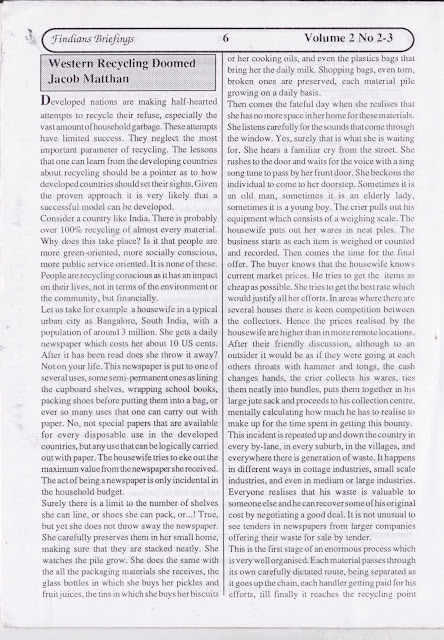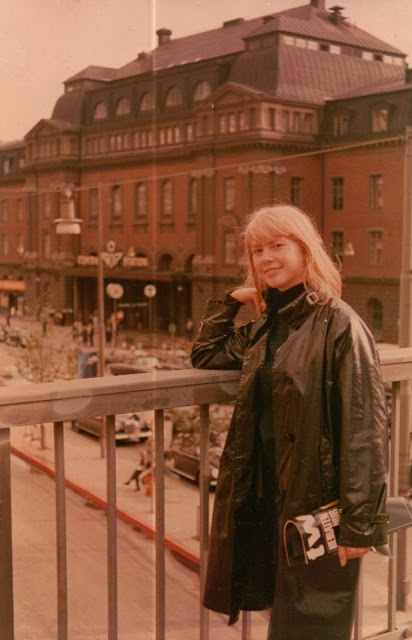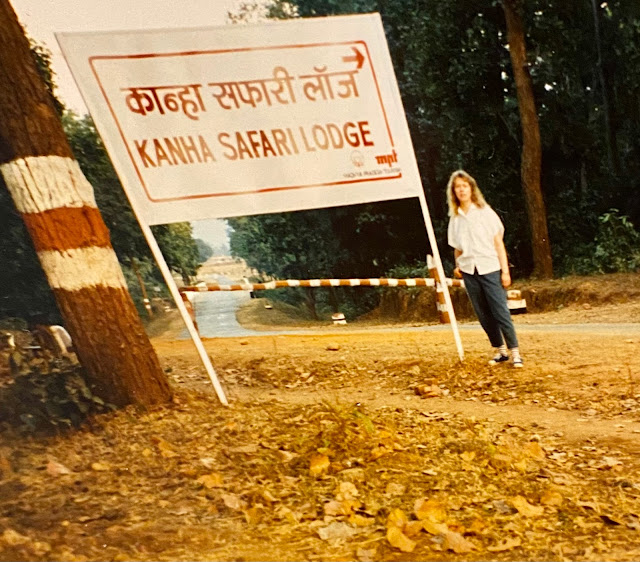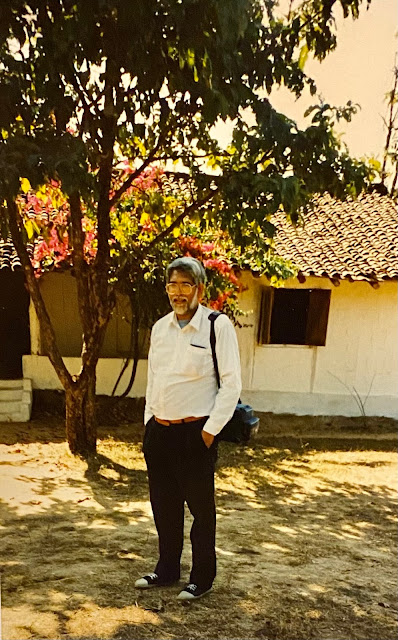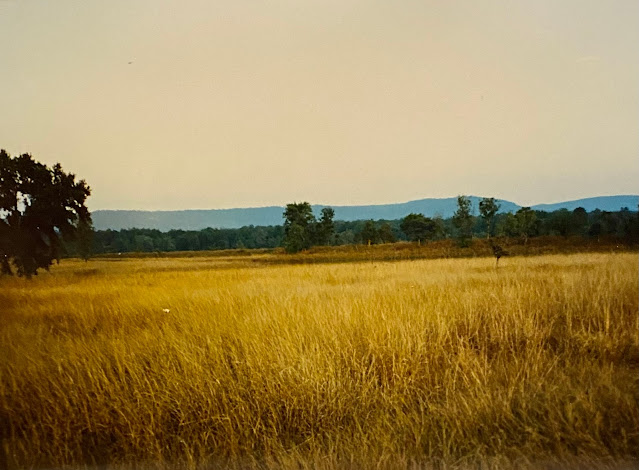I return to subject of the environmental chaos in India - this is not a political statement but a continuation of what we have written about continuously for over 30 years.
We are lucky today to live in the 4th most Living Green country in the world, Finland,
India comes in near the bottom of the global rankings at 168th place worldwide, and only Afghanistan (178th place) ranks below India in Southern Asia. Leading the region is Bhutan (107th), with relatively high scores in biodiversity & habitat protection. (Many Indians will claim that is a western conspiracy against India to run it down!)
Yesterday, I read in The Wire this article by Elisha Vermin:
‘If Only the Government Worked as Hard as Waste Pickers’
Hundreds of scrap dealers are recycling most of Delhi’s plastic waste while being on the run from the government.
Bahadurgarh: Among the flurry of lush green farmlands at the Delhi-Haryana border, hundreds of scrap dealers are involved in the process of recycling nearly all of Delhi’s plastic waste tucked safely away from the city’s eyes.
A few kilometres from Tikri Kalan’s PVC market, one of the biggest legitimate plastic markets in Delhi, acres of agricultural land in Shiddipur and Lowa Kalan has been turned into an open plastic market. Each trader in this area deals with nearly 300-500 kg of plastic waste per day.
According to a report by the Centre for Science and Environment, Delhi generates over 600 tonnes of plastic waste daily. Most of this waste is brought to plastic markets like the one at Tikri where these dealers or aardhis segregate and reduce it to shreds before selling it forward. They are the most important link in the plastic recycling chain, and also the ones facing the most harassment.
Running nearly entirely as an informal economy, aardhis have the skill and eye to sort the waste without any chemical testing or lab equipment. All they need is empty stretches of land. However, they are constantly caught in a cat-and-mouse chase with the authorities. “First we were removed from Mundka, then from Kamruddin Nagar and they are still chasing us away even after we’ve crossed the Delhi border” said 38-year-old Rajesh, an aardhi at the Shiddipur market.
Rajesh and Bablu weren’t the only aardhis angry with the government. The huddle of two gradually swelled to about 15 men and a few women all expressing their frustration at the treatment they receive from the municipal corporation and National Green Tribunal officials. “They come and raze our temporary structures whenever they feel like it. I want to quit this profession now. If the government worked as hard as the waste pickers, the country would be elsewhere,” said 55-year-old Mangeram, who lost most of his business when he left the market at Mundka.
Aardhis believe that they are not the problem, but a solution to a problem. “The plastic is not going to decompose itself. If we don’t clean this mess then there will be heaps lying around in the city,” said 25-year-old Sonu, who works with his father at the market in Lowa.
Truckloads of plastic waste is unloaded at the market every few hours.
The aardhis told me that it’s not just Delhi’s waste that makes it way to these plastic markets. The government imports plastic waste, charges a custom duty on it and then the dealers pay an 18% GST on subsequent trading.
“Nobody is trying to shut down the bigger factories contributing to pollution in broad daylight because their owners can pay off the officials. We are preventing pollution on the other hand but nobody cares,” a 36-year-old aardhi who did not want to be named, said.
These traders work under the scorching sun without access to toilets or a clean resting place in the absence of a refuge away from the piles of waste. While they pride themselves on keeping Delhi “from coming to a standstill, trapped under its own garbage”, most of them seem to have lost hope and plan to move back to their villages if they face further harassment by government officials.
It is ironic that their contribution to waste management doesn’t guarantee them any financial or personal security. To quote Kaveri Gill, the author of Of Plastic and Poverty, who was one of the first few to document Delhi’s informal recycling markets: “If we can’t help them, leave them alone.”
Developed in collaboration with Ekaansh Arora.
As I am, by profession, a Plastics Technologist, this article specifically interested me. Now that I am retired for over 15 years, the only subject in plastics I do still follow is the recycling of plastics as it is a highly controversial one.
Plastics as a material is demonised rather than the people who misuse plastics.
When I was working in England at the British Rubber and Plastics Research Association (RAPRA) of Great Britain, one of my several projects was to counter the complaint by many professions, especially archiects that claimed that plastics did not have any durability!
One of my tasks was to prove to the the scientific world that plastics was a durable material. I searched all around England to find proof of the durability of plastics.
The oldest use of plastics I found then was an acrylic dome roof light system in the centre of London which had then lasted 30 years with no problems.
This was documented in a paper "Weathering of Plastics" published in October 1968 in the journal Plastics which was authored by Dr. Crowder of the Building Research Station and myself. It shows a photograph that I captured during my time at the research centre.
Over the two years of my study, which took me across and up and down the English country, I found many uses of plastics which had withstood the elements and performed better than any comparable material.
I stood on the roof of Wembley Stadium, confident that I was standing on a thin reinforced plastic sheeting with no loss in its strength as the sheer drop was many tens of metres!
I authored over 11 major reviews which covered all the plastics materials and their durability that were exposed to the elements.
That established the lovengity of plastics and should have been the guiding light to users that plastics was going to be a problem if it was used in applications where they would not be degraded!
In 2022 the production of plastics was estimated as 450 million tonnes. Of this, it is estimated that 44% is used for packaging, a totally unnecessary waste of an most important resource!
Unfortunately, plastics became fashionable and started to be used in disposable packaging, something that should never have been permitted. The first step should have been that the use of plastics for packaging should have been subjected to the obsolescence law.
Today we are suffering the environmental consequences of the misuse of plastics.
When I returned to India I saw the use of plastics was becoming rampant in packaging. I took up this matter with the late Lavraj Kumar who was the Advisor to the Ministry of Petrochemicals. He listened but was powerless in the face of political pressure.
It was very appropriate those days to push the use of plastics for packaging of consumable foodstuffs as the losses due to infestation and rodents due to poor packaging and storage was enormous.
Plastics became the life saver but it grew and grew unchecked with no control on the environmental impact.
But India had its own solution as the jerrypuranawalla moved street by street collecting the waste materials and these were then regenerated back to useful materials, going down the chain till finally it was used in non critical applications.
Hence, India had a solution and as can be seen from the map it topped the world in the recycling of plastics.
I still remember driving in Bombay from Sion towards Chamber where, on one side of the road, there was a "plastics ghat" where used plastics film could be seen drying in the sun after washing till it was then sent for re-extrusion and generation into plastics granules for further use.
This scavenging and regeneration provided employment for many thousands of people around the country. The chain was perfect as everyone benefitted financially.
The purpose should have been to develop this as a regular industrial activity with adequate input of technology, but it has stayed for generations in this unorganised fashion.
It is, therefore, no wonder that the recyclers of Delhi are treated as persona non-grata instead of valuable contributors to the Indian economy.
This 1993 article written by me, which appeared in ”Findians Briefings”called for "Western Recycling Doomed" was reposted in our blog in 2020.
When we wrote our blog entry "The Garbage Dump - India" we pointed out that the Environmental Minister of that time, Jairam Ramesh, had stated that India should be given the Nobel Prize for the filth of the world!
If there is a Nobel prize for filth, India will win it: Jairam Ramesh
In this, plastics is a major contributor.
If the authorities are not able to control it with the correct approach in technology, do not punish those who, by their own initiative, are trying to reduce the impact on the environment.
I firmly stand with the people, who despite all odds, are part of the chain reclaiming plastics in India!






